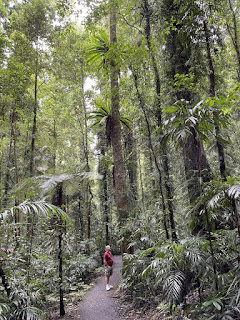Monday, January 25, 2021
The Lucky Country
Saturday, January 23, 2021
Homeward Bound
The final two stops on our journey home from Ballina proved to be a hit and a miss. Our first stop was the Harrington River Lodge overlooking the expansive Harrington River. Garry and I stopped here several years ago and were duly impressed by the burgeoning planned community taking shape along the river bank. We were curious to see if our first impressions would hold up during a second visit.
I'm delighted to say that Harrington continues to impress us. The community continues to flourish and the facilities have been well maintained. We spent two relaxing nights here. The sunset on the first night was undoubtedly a real highlight of our vacation. Once again we were entertained by dolphins frolicking in the river's tranquil waters and pelicans balancing delicately on local street lamps.
However, the surprise highlight on our journey south was Nambucca Heads. On a whim, we decided to take a brief detour and visit this seaside town. The vista that greeted us as we pulled into a lookout on the headlands simply took our breath away. The town sits on the mouth of a picturesque river, punctuated by sweeping white sand bars. The headlands also include a small, sheltered lake nestled behind a coastal breakwater. All in all, it was an impressive location. We've decided we'll sneak back here soon for a long weekend.
Our final stop on our way to Sydney was Bannisters in Port Stephens. Rick Steins has a popular seafood restaurant here and the hotel's review are punctuated by images of sublime coastal views. However, our stay at this pricey upmarket motel-style resort proved disappointing. It was our most expensive accommodation yet delivered the least impressive experience. I honestly felt royally ripped off and was rather embarrassed I’d gifted Garry the cost of our stay for Christmas.
First, our ocean view room wasn't located on the building’s ocean-facing facade. Instead, we found ourselves sharing a barren marble clad balcony with three other rooms. This meant the room offered limited privacy and our view of the neighbouring park’s trees wasn't worth the premium price we paid.
Second, the hospitality staff’s service varied from excellent to downright mediocre. The service at breakfast both mornings was particularly woeful. We had to chase down the staff to get a coffee and cutlery. Identical meals arrived with missing accoutrements. The toast we ordered never arrived. In all honesty the breakfast we enjoyed in the mountains at Dorrigo was street ahead of Bannisters.
However, there were a few memorable highlights. Dinner at Rick Steins was superb, as was our lunch at the Point Restaurant in nearby Solider's Point. However, these culinary treats won’t tempt us back to Bannisters any time soon.
Dorrigo National Park
Garry and I have spent the first week of the new year making our way home after a much-needed Summer vacation in Ballina. Our return journey has been broken into three separate scenic stops. Our first stop takes us inland to Dorrigo National Park. This tranquil location sits on the popular Waterfall Way, a scenic highway that winds its way over the Great Dividing Range between Coffs Harbour and Armidale.
We based ourselves for two nights at the Lost Mountain Resort a few kilometres east of Dorrigo township. This proved to be a superb venue. The resort's cafe served an awesome breakfast. The surrounding mountain views and local birdlife were equally sublime. However, the region is best known for its spectacular waterfalls.
During our stay, we visited the impressive Dangar Falls, walked the Wonga Track to the equally impressive Crystal Shower Falls and stopped to admire two smaller falls that cascade down the slopes and pass directly under the local highway.
The Wonga Walk proved to be a real highlight. We saw plenty of birdlife along the way including a male Bush Turkey building an enormous nesting mount, King Parrots and some adorable finches. The Crystal Shower Falls were well worth the 3km round trip hike.
The approach to the falls is marked by a suspension bridge that carries walkers across the valley in front of the falls. From here a short side track takes you behind the falls where you can look through the cascading veil of water.
The National Park's Rainforest Centre also featured an impressive Skywalk. This cantilevered gangway stretches out over the canopy rewarding visitors with an uninterrupted view across the National Park's scenic valleys.




























